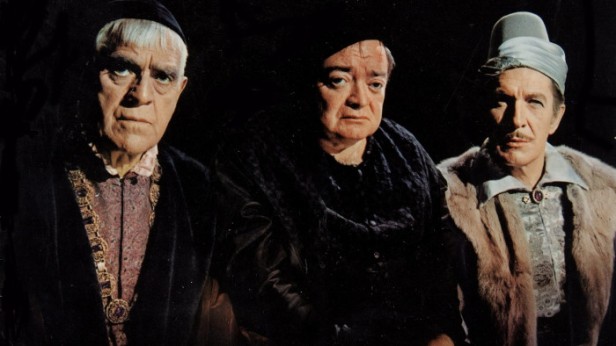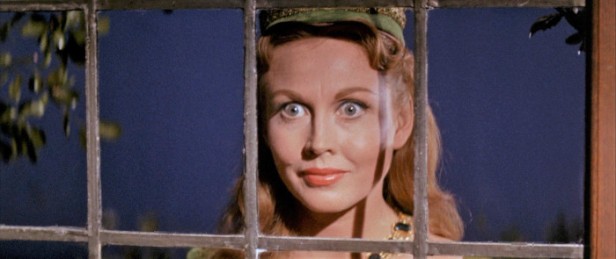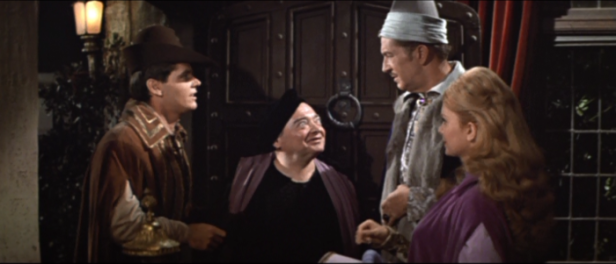Director Roger Corman and screenwriter Richard Matheson seemed to have had fun with the more comedic tone of The Black Cat segment of Tales of Terror (1962) and decided to make a whole feature in a lighter mood. On paper, it seemed like a good idea – the Corman/Poe series, of which this was the fifth, was ripe for spoofing at this stage. Unfortunately, the resulting film wasn’t terribly funny. It has its moments but they’re few and far between, the attempts at humour wearing very thin, very quickly.
Comedy is famously terribly subjective and what is flat out hilarious to some falls flat for others. And while there are a few sophisticated gags here and there, there’s a lot of cringeworthy juvenilia too (Lorre’s adlibbed “you dirty old man!” after Scarabus causes Bedlo’s magic wand to droop is a particular low point). None of it is helped one iota by Les Baxter’s dreadful score which constantly cues us to “laugh now” – had he toned it down a little and allowed audiences to make their own decisions, perhaps some of the mild humour might have been more effective.

In 1506, sorcerer Dr Erasmus Craven (Vincent Price) is mourning the death of his beloved wife Lenore, still deep in grief after two years, when he’s visited by a talking raven who turns out to be the wizard Dr Bedlo (Peter Lorre). After helping Bedlo return to human form, he learns that Bedlo had been turned into a bird in the first place by a hated rival, Dr Scarabus (Boris Karloff) and that he apparently saw Lenore alive and well at Scarabus’ castle. They decide to call on Scarabus whith Craven’s daughter Estelle (Olive Sturgess) and Bedlo’s son Rexford (Jack Nicholson) along for the ride. Much double crossing and back-stabbing ensues before we learn that Lenore (Hazel Court) faked her own death to become Scarabus’ mistress and it all ends in a battle to the death between an enraged Craven and an unrepentant Scarabus.
Things take a turn towards the more serious once we arrived at Scarabus’ castle (though Baxter barely seemed to notice…) and the film really starts to perk up. Like so many of the Corman Poes it starts and ends well but sags alarmingly in the mid-section and while leaving us stranded with slow but atmospheric Gothic business was tolerable, leaving us with a parade of feeble jokes is less so. But once the full cast is finally assembled, there is at least some not inconsiderable pleasure to be had from seeing all those familiar faces gathered together in one beautifully appointed place (Daniel Haller’s set designs are as ravishing as ever). Karloff is particularly good and his arrival seems to force everyone to up their game a little, despite him being in ill-health at the time (hence him remaining seated for much of the time), Price gets slightly less screen time than usual in these things but very much makes the most of it, and Hazel Court, making the second of her three appearances in the Corman Poes (she’d previously been in The Premature Burial (1962) and would go on to The Masque of the Red Death (1964)) is terrific and more than holds her own against her exalted co-stars.

The only weak links in the acting chain are provided by Nicholson, who seems ill-at-ease and a far cry from the often-mesmerising Hollywood titan he would become, and Lorre who seemed hell bent on delivering his improvised nonsense (he was no comedy writer, let’s be honest) at full volume. When Bedlo is apparently reduced to a puddle of raspberry jam, Rexford seems barely troubled by it and some of us were rather relieved to be shot of him for a while. At his best (see Fritz Lang’s magnificent M (1931), Hitchcock’s The Man Who Knew Too Much (1934) and Karl Freund’s Mad Love (1935) for examples) he was capable of nuanced and often very creepy performances but here he hams it up mercilessly.
It all culminates in a fun duel of the sorcerers as Craven and Scarabus square up against each other for a blaze of cheap but plentiful visual effects, far more than we’d usually expect from a Corman film (the two magicians firing beams of energy at each other from their fingertips anticipates the force energy seen in the Star Wars films). You might be wondering what any of this has to do with Poe’s 1845 poem, a character study of grief, obsession and remorse. The fact it is that it takes the title, a talking raven, a few quotes and nothing else. Matheson thought it was inherently funny that anyone would want to make a film out of a poem and was forced to largely make up the entire plot to get anything like a full feature.

It’s a toss up between The Raven and The Tomb of Ligeia (1964) as to which is the weakest of the Corman Poe adaptations. Tomb is slow and often quite ponderous, but it makes up for it with stunning use of the English countryside locations (we get a brief return to what looks like the coast of Palos Verdes here) and The Raven scores extra points for its fascinating cast, even if not all of them are firing on all cylinders.
During production, Corman decided that he was familiar enough with Poe’s style now to come up with a freshly minted story in the author’s style and, left with little to do on the penultimate weekend of filming on The Raven when bad weather wrote off his planned tennis game, Corman decide that he could recycle Daniel Haller’s magnificent sets before they were broken up to make another film. Using a script written in haste by Leo Gordon, Charles B. Griffith and Jack Hill, and despatching his young protégées Francis Ford Coppola, Dennis Jakob, Monte Hellman, Hill and Nicholson to shoot additional location footage he retained Karloff and Nicholson to film two days worth of new material. The resulting quickie, The Terror, was released to US cinemas in June 1963 on the same day as The Raven.